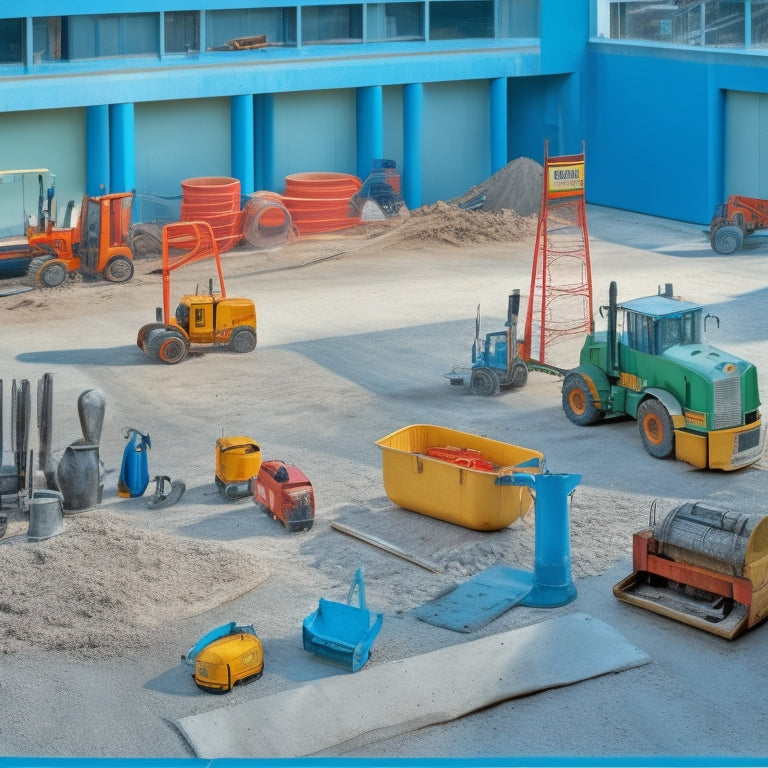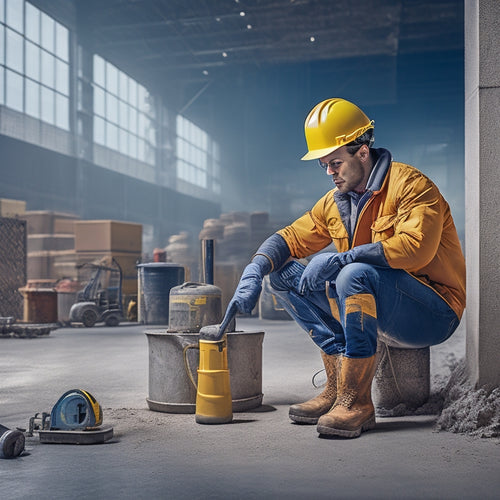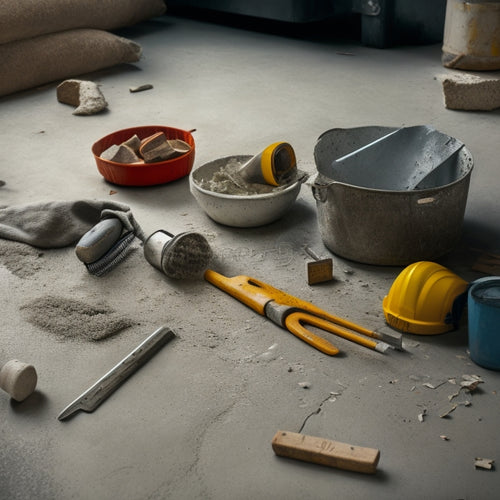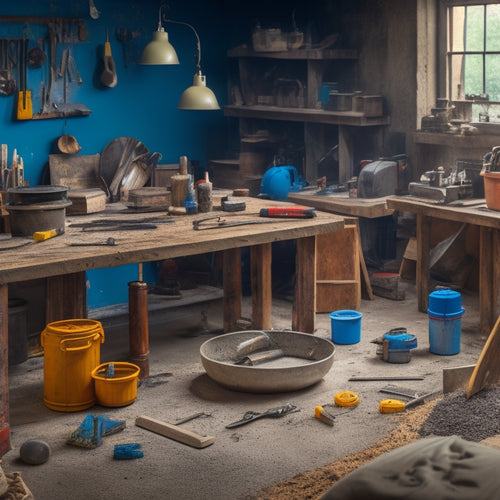
What Tools Do I Need for Concrete Slab Pouring
Share
You'll need a range of tools and equipment to successfully pour a concrete slab, including a concrete mixer, concrete pumps, wheelbarrows, buckets and ropes, chute or concrete pump, screed board, trowel, float, bull float, edger, and jointer or groover. Safety gear like hard hats, safety glasses, steel-toed boots, gloves, and dust masks are also essential. Additionally, you'll require measuring and marking equipment, concrete mixing and pouring tools, finishing and smoothening tools, and specialized tools for cutting, shaping, and cleaning. As you prepare for your concrete slab pouring project, take a closer look at each of these tools to guarantee a professional finish and safe working environment.
Key Takeaways
• Essential tools for concrete slab pouring include a concrete mixer, concrete pumps, wheelbarrows, screed boards, and trowels for a solid finish.
• Measuring and marking equipment like measuring tapes, marking chalk, and sturdy hooks ensure precise measurements and accurate marks.
• Safety gear such as hard hats, safety glasses, steel-toed boots, gloves, and dust masks protect workers from injuries and hazardous materials.
• Finishing and smoothening tools like tamping tools, bonding agents, and specialized trowels help achieve a smooth, even finish and uniform density.
• Cleanup and removal tools like brooms, blowers, scrapers, and debris collection areas are necessary for post-pour cleanup and site maintenance.
Essential Concrete Slab Pouring Tools
You'll need six vital tools to guarantee a successful concrete slab pouring process: a concrete mixer, a bull float, an edger, a tamping tool, a spirit level, and a screed board. These tools will help you achieve a smooth, even, and durable concrete slab, regardless of the type you're pouring - be it a residential slab, commercial slab, or industrial slab.
When it comes to pouring techniques, having the right tools is essential. With a concrete mixer, you'll be able to mix the perfect blend of cement, water, and aggregate. The bull float will help you remove air pockets and create a smooth surface. The edger will define the slab's edges, while the tamping tool will compact the concrete.
A spirit level will verify the slab is perfectly level, and a screed board will help you achieve the desired thickness. By using these essential tools, you'll be able to master various pouring techniques, such as the 'pour and finish' method or the 'pump and place' method, and achieve a high-quality concrete slab that meets safety standards and building codes.
Safety Gear for Concrete Pouring
Your personal protective equipment (PPE) is essential when pouring concrete, as it shields you from hazardous materials, falling objects, and equipment misuse. You'll need to invest in a range of safety gear to guarantee your protection on site.
Here are some essential safety items to include in your concrete pouring kit:
| Safety Gear | Description | Importance |
|---|---|---|
| Hard hat | Protects your head from falling objects | Prevents head injuries |
| Safety glasses | Shields your eyes from debris and chemical splashes | Prevents eye damage |
| Steel-toed boots | Protects your feet from heavy objects and crushing | Prevents foot injuries |
| Gloves | Provides grip and protection from cuts and abrasions | Prevents hand injuries |
In addition to PPE, you should also undergo safety training to learn how to handle equipment safely and respond to emergencies. This training will teach you how to identify hazards, use safety equipment correctly, and follow safe working practices. By combining PPE with safety training, you'll be well-equipped to handle the risks involved in concrete pouring and guarantee a safe working environment.
Measuring and Marking Equipment
Accurately measuring and marking the concrete slab area is essential to guarantee a successful pour, and this relies on having the right measuring and marking equipment at your disposal.
You'll need measuring tapes that are durable, accurate, and easy to read. Look for tapes with clear markings and a sturdy hook that won't slip or bend while taking measurements. A 25-foot or 30-foot tape should be sufficient for most concrete slab pours.
Marking the area is just as vital, and that's where marking chalk comes in. This type of chalk is specifically designed for marking concrete and is easy to see, even on dark or dusty surfaces.
You'll use it to mark the perimeter of the slab, as well as any obstructions or features that need to be avoided. Make sure to choose a high-quality marking chalk that's resistant to fading and can withstand the elements.
With the right measuring and marking equipment, you'll be able to ascertain accurate and precise measurements, which is critical for a successful concrete slab pour.
Concrete Mixing and Pouring Tools
As you prepare to pour a concrete slab, you'll need to transport mixed concrete to the pour site.
Use specialized equipment to pour it smoothly, and have the right finishing tools on hand to achieve a professional finish.
You'll be working with heavy, high-volume materials, so it's crucial to have the right tools for the job.
In this section, we'll cover the must-haves for mixed concrete transport, concrete pouring equipment, and finishing tool essentials.
Mixed Concrete Transport
You'll need to transport mixed concrete from the mixing site to the pouring location, and this is where the right tools come into play. Efficient concrete transport logistics are essential to guarantee the mixed concrete delivery reaches the pouring location without compromising its quality. You'll need to take into account the distance, terrain, and size of your pour to determine the best transportation method.
Here are some common tools used for mixed concrete transport:
| Tool | Description | Capacity |
|---|---|---|
| Concrete Mixer Trucks | Large trucks with rotating drums for mixing and transporting concrete | 6-12 cu.yd. |
| Concrete Pumps | Pumps that transport concrete through hoses or pipes | 20-100 cu.yd. per hour |
| Wheelbarrows | Hand-operated carts for small pours and tight spaces | 2-6 cu.ft. |
| Buckets and Ropes | Manual transport using buckets and ropes for small, remote pours | 1-2 cu.ft. |
When selecting a transportation tool, take into account the size and complexity of your pour, as well as the safety of your crew. Make certain to follow safety guidelines and best practices to prevent accidents and guarantee a successful pour.
Concrete Pouring Equipment
With the mixed concrete successfully transported to the pouring location, it's crucial to deploy the right concrete pouring equipment to guarantee a smooth, efficient, and high-quality pour. You'll need a range of tools to make sure the concrete is poured correctly and evenly.
A chute or concrete pump will help you direct the flow of concrete accurately, while a screed board or vibrating screed will aid in leveling and compacting the concrete. A bull float or darby will come in handy for spreading and flattening the concrete, especially in larger pours.
When it comes to concrete pouring techniques, it's important to follow slab preparation methods that guarantee a solid foundation. This includes removing any debris, compacting the subgrade, and applying a bonding agent to the surface.
By using the right equipment and following proper techniques, you'll be able to achieve a flawless finish and a strong, durable slab.
Remember to always prioritize safety when working with concrete, wearing protective gear and following established guidelines to avoid accidents.
Finishing Tool Essentials
Six essential finishing tools are required to achieve a smooth, high-gloss finish on your concrete slab.
As you progress from the pouring stage, it's vital to equip yourself with the right tools to achieve the desired finish. First, you'll need a trowel to spread and smooth out the concrete. Mastering trowel techniques is key to achieving a uniform finish.
Next, a float will help remove excess water and even out the surface. An edger is essential for creating clean, defined edges and corners. To add the finishing touches, a jointer or groover will help create expansion joints, allowing the slab to expand and contract with temperature changes.
A finishing broom or tamping tool will add texture and help prevent slipping. Finally, a concrete sealer will protect your slab from the elements and enhance its appearance.
Remember to always follow safety guidelines when working with these tools, wearing protective gear and ensuring a stable working environment. With these finishing tool essentials, you'll be well on your way to a professional-looking concrete slab.
Finishing and Smoothening Tools
As you shift to the finishing stage, tamping tools, such as hand tampers or power tampers, help compact and smooth out the concrete surface, ensuring a uniform density and preventing uneven settlement.
Next, you'll need to focus on trowel techniques to achieve a smooth, even finish. Use a bull float or a fresno trowel to apply a thin layer of cement paste, known as a 'screed,' to the surface. This helps to fill in any imperfections and creates a uniform base for further finishing.
For texture application, you can use specialized trowels with different textures or patterns. These can range from a simple broom finish to more intricate designs. Remember to always work in small sections, using a consistent motion to achieve the desired pattern.
It's crucial to maintain a safe working environment, so be sure to wear protective gear, including gloves, safety glasses, and a dust mask.
Concrete Cutting and Shaping Tools
You'll need to precision-cut and shape the concrete slab to fit around obstructions, create curved edges, or achieve specific design features, which requires a range of specialized tools and techniques.
To accomplish this, you'll rely on concrete cutting and shaping tools that can handle the tough, abrasive nature of concrete. For cutting, you'll need a concrete saw or a diamond blade saw, which utilize advanced cutting techniques to make precise cuts. These saws are designed to reduce dust and debris, ensuring a safer working environment.
For shaping, you'll use tools like edgers, groovers, and trowels, which employ specialized shaping methods to create curved edges, joints, and other design features.
It's crucial to choose the right tool for the specific task, as the wrong tool can lead to inaccurate cuts, wasted material, and potential safety hazards.
Cleanup and Removal Tools
As you move on to the finishing stages of your concrete slab pouring project, you'll need to focus on cleanup and removal to guarantee a smooth, even surface.
You'll be working with a range of tools to get rid of debris, remove excess concrete, and clean the surface.
From debris removal equipment to concrete chiseling tools and surface cleaning agents, you'll need the right tools to get the job done efficiently and effectively.
Debris Removal Equipment
Remove debris efficiently with the right equipment, such as brooms, blowers, and scrapers, to guarantee a clean and even surface for your concrete slab pour. Proper debris removal is essential for site cleanliness and guarantees a successful pour.
You'll need brooms to sweep away loose materials, blowers to remove dust and dirt, and scrapers to clear away stubborn debris.
When it comes to debris disposal, make certain you have a plan in place. Designate a specific area for debris collection and verify it's easily accessible. This will help maintain site cleanliness and prevent accidents.
You should also have a system for disposing of debris, such as dumpsters or trash bins, to keep the site organized and safe.
Concrete Chiseling Tools
Your concrete chiseling tools, including chisels, hammers, and pry bars, are essential for breaking up and extracting old, damaged, or excess concrete, allowing you to start with a clean slate for your new slab pour.
You'll need various chisel types, such as flat, point, and claw chisels, to tackle different concrete removal tasks. Flat chisels are ideal for breaking up large areas, while point chisels are better suited for precision work. Claw chisels, with their curved ends, are perfect for prying and removing small concrete pieces.
To guarantee your chiseling tools remain effective and safe to use, follow these maintenance tips: regularly clean and inspect your tools, store them in a dry place, and sharpen or replace them as needed.
Additionally, always wear protective gear, including gloves, safety glasses, and a dust mask, when operating chiseling tools. This will prevent injuries and exposure to hazardous materials.
Surface Cleaning Agents
After breaking up and extracting unwanted concrete, you'll need to clean the surface thoroughly with specialized agents to guarantee a strong bond between the old and new concrete. Proper surface preparation is essential for a successful concrete slab pouring project.
You can't just pour new concrete over a dirty, contaminated surface and expect it to adhere properly. That's why you need effective cleaning solutions to remove dirt, oil, and other substances that can compromise the bond.
Here are some important surface cleaning agents to have in your toolkit:
-
Concrete degreasers: These solutions can dissolve and remove oil, grease, and other hydrocarbons that can interfere with the bonding process.
-
Acid-based cleaners: These agents can etch the surface of the old concrete, creating a rough texture for the new concrete to bond to.
-
Alkaline-based cleaners: These solutions can neutralize acidic substances on the surface and remove dirt and grime.
- Pressure washer cleaning solutions: These agents can be used in conjunction with a pressure washer to blast away dirt and debris from the surface.
Specialized Concrete Pouring Accessories
When pouring concrete slabs, you'll find that specialized accessories can greatly enhance the efficiency and quality of the process. These accessories include specialized mixers, pouring buckets, and finishing tools that help you achieve a smooth, even surface. With the right accessories, you can optimize your pouring techniques and minimize the risk of defects or imperfections.
Here are some essential specialized concrete pouring accessories to take into account:
| Accessory | Description | Purpose |
|---|---|---|
| Specialized Mixers | High-torque mixers for mixing large batches | Guarantee consistent mix quality |
| Pouring Buckets | Heavy-duty buckets with pouring lips | Facilitate smooth, controlled pours |
| Finishing Trowels | High-carbon steel trowels for smooth finishes | Achieve a smooth, even surface |
| Edging Tools | Specialized tools for creating clean edges | Create sharp, defined edges |
| Concrete Vibrators | Portable vibrators for eliminating air pockets | Guarantee a strong, durable slab |
Frequently Asked Questions
Can I Pour Concrete in Extreme Weather Conditions?
When you're planning to pour concrete, you need to take into account the weather conditions.
You shouldn't pour concrete in extreme cold weather, as it can affect the concrete temperature and its overall strength. Ideally, the concrete temperature should be between 50°F and 70°F for proper curing.
If you pour in cold weather, the concrete may not cure properly, leading to cracks and weaknesses.
It's better to wait for a more favorable weather condition to guarantee a strong and durable concrete slab.
How Long Does It Take for Concrete to Fully Cure?
You're probably wondering how long it takes for concrete to fully cure.
The cure time depends on various factors, including the type of concrete, temperature, and humidity.
Typically, it takes around 28 days for concrete to reach its full strength, but the curing process can take up to 90 days.
During this time, you'll need to keep the slab moist and protected from extreme weather conditions.
What Is the Ideal Thickness for a Concrete Slab?
Did you know that the Romans built concrete structures that still stand today?
When it comes to your concrete slab, you'll want to get the thickness just right. You're aiming for a minimum slab thickness of 4-6 inches, depending on the load capacity you need.
Thicker slabs can handle heavier loads, but they're also more expensive. For a standard residential slab, 4 inches should suffice.
Just remember, a stronger slab means a safer structure.
Can I Use a Regular Drill for Mixing Concrete?
You're wondering if you can use a regular drill for mixing concrete? Don't risk it!
A standard drill can't handle the thick, heavy mixture, and you'll end up damaging the tool or worse, injuring yourself.
Instead, invest in a heavy-duty drill or a mixing paddle designed for concrete mixing. This will guarantee efficient mixing techniques and a consistent finish.
Do I Need to Apply a Sealant to the Finished Concrete Slab?
Are you wondering if your newly poured concrete slab is truly complete without a sealant? You're right to think so!
To guarantee durability and protect against stains, you'll want to apply a sealant. There are various sealant types, such as acrylic, epoxy, and polyurethane, each with its own benefits.
When it comes to sealant application, make certain to follow the manufacturer's instructions and take necessary safety precautions to avoid exposure and slippery surfaces.
Conclusion
Congratulations, you've made it this far without getting stuck in the mud (or concrete, for that matter)!
You now have the ultimate list of tools needed for concrete slab pouring.
Don't even think about attempting this project without them, or you'll end up with a slab that's as useful as a chocolate teapot.
With these essentials, you'll be well on your way to creating a concrete masterpiece that'll make even the most seasoned pro nod in approval.
Related Posts
-

10 Best Tools for Sealed Concrete Flooring on Budget
When starting on a sealed concrete flooring project on a budget, you'll need to prioritize essential tools without sa...
-

Top 10 Concrete Repair Tools for Small Fixes
You'll need the right tools to tackle small concrete repairs efficiently and effectively. When it comes to small fixe...
-

Budget-Friendly Tools for DIY Decorative Concrete Profiling
You can achieve professional-grade decorative concrete results on a budget by investing in the right combination of e...


